Exploring the Intricacies of Fractal Art
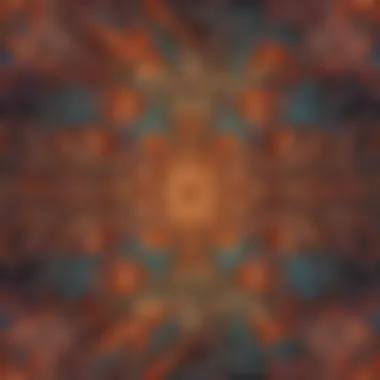
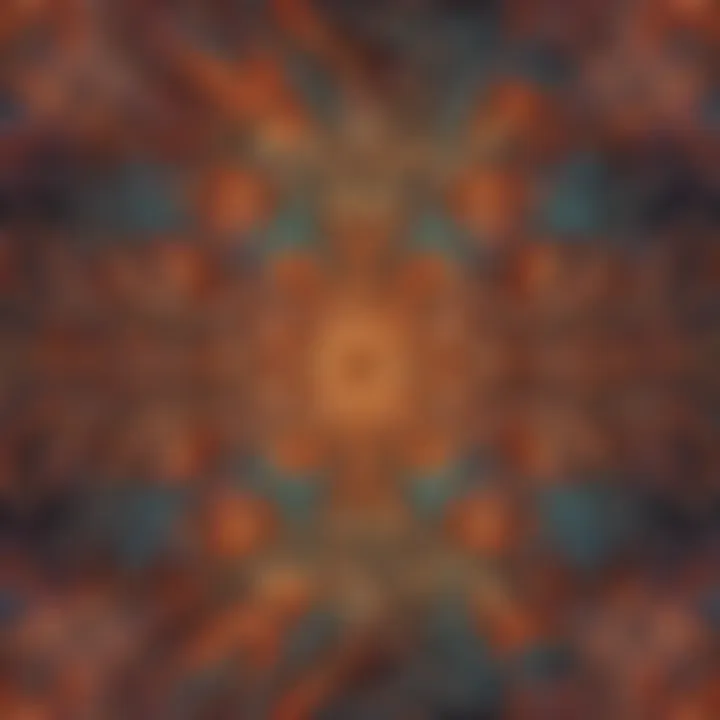
Intro
Fractal art is a unique blend of mathematical precision and artistic expression. At first glance, the beautiful patterns and shapes may seem simply aesthetic, but they hide a world rich in complexity and logic. For young science enthusiasts, understanding fractals can be a gateway into both mathematics and art. The aim of this guide is to dissect the fundamental aspects of fractals, explore the tools used to create them, and demonstrate their relevance in our lives today.
Learning about fractal art opens doors to a variety of concepts in mathematics, physics, and computer science. It not only encourages creativity but also fosters an appreciation for the intricate and often surprising relationships between numbers and visual forms.
Science Fun Facts
Fractals are not just artistic wonders; they come with a treasure trove of fascinating facts:
- Self-Similarity: One core concept of fractals is self-similarity. This means a small part of a fractal can resemble the whole fractal as you zoom in.
- Infinite Complexity: Despite being formed by simple rules, fractals can create images of incredible complexity. This complexity is what makes fractal art so captivating.
- Nature's Patterns: Many natural forms are fractals. For example, coastlines, snowflakes, and ferns display fractal-like characteristics in their structures.
- Mathematical Discovery: The term
Prologue to Fractals
Fractals are a fascinating intersection of art and science, showing deep mathematical principles while also providing a canvas for creativity. Understanding the concept of fractals is essential because it forms the foundation upon which fractal art is built. This section serves to highlight the significance of studying fractals not only from a mathematical viewpoint but also as a means of expression. By grasping the basic principles of fractals, enthusiasts can better appreciate the intricate designs and forms that arise from mathematical algorithms.
Understanding Fractals
Fractals are complex structures that exhibit self-similarity, meaning that they look similar at any scale. An important characteristic of fractals is that they can be infinitely intricate. The simplest example is the Mandelbrot set, where the boundary reveals an endless level of detail upon magnification. Fractals emerge from simple mathematical rules that repeat over and over again. This repetition leads to rich patterns, demonstrating that profound complexity can arrive from equally simple equations.
The importance of understanding fractals lies in recognizing their applications across various fields. They are used in physics, computer science, and even nature. For instance, natural objects such as trees, clouds, and mountains often have fractal-like structures. Appreciating their mathematical beauty can enhance one’s creativity and understanding in related scientific areas.
Historical Background
The history of fractals dates back long before they became recognized as an art form. In the late 19th century, mathematicians like Georg Cantor began to explore sets that could possess infinite properties. However, the term 'fractal' was first introduced by mathematician Benoît Mandelbrot in the 1970s. His work highlighted the resemblance of these structures to natural phenomena, marking a turning point in the perception of mathematics.
Mandelbrot's discovery opened the door for artists to engage with fractals and incorporate them into their work. This blending of mathematics and art led to the rise of fractal art in the 1980s and 1990s. Artists began using algorithms to generate complex artworks, providing new visual experiences. The historical context illustrates how fractals evolved from pure mathematical interest into a rich field of artistic creation.
"Fractals are not just aesthetic; they imply a deeper relationship between art and the mathematical world."
Fractal art continues to evolve, captivating minds across generations. Understanding this history allows an appreciation of how both the sciences and arts can come together to represent complex realities.
Mathematics Behind Fractals
The relationship between mathematics and artistry is vividly apparent in fractals. The study of fractals extends beyond mere shapes; it incorporates complex mathematical principles that inform their creation and structure. Understanding these mathematical foundations not only enhances the appreciation for fractal art but also enables artists to manipulate and innovate within this unique genre.
Definition and Properties
Fractals are defined as patterns that repeat at different scales. They possess certain unique properties that distinguish them from traditional geometric shapes. Key characteristics include:
- Complexity: Fractals are often born from simple mathematical formulas that create intricate and beautiful patterns. This complexity can be found in natural phenomena, such as clouds, mountains, and rivers.
- Infinite Detail: One striking feature of fractals is that they can be zoomed into indefinitely. No matter how closely one examines a fractal, more detail always appears. This property stems from their self-similar nature, where structures look similar at various sizes.
- Non-Integer Dimensions: Another fascinating aspect is the concept of dimensions in fractals. Unlike conventional shapes that consist of whole number dimensions, fractals blur those lines, often exhibiting dimensions that are fractional. This property can be understood through the concept of the Hausdorff dimension, which helps to quantify how completely a fractal seems to fill space.
These elements mark fractals as an intriguing intersection point between mathematics and art. They can provide insights into chaotic systems and algorithms, while also offering a framework for artists to explore creativity through structured complexity.
Self-Similarity and Infinite Detail
Self-similarity is the notion that a fractal can exhibit similar patterns or shapes at various scales. This property is essential in understanding how fractals are formed and perceived.
In essence, when one zooms in on a fractal, segments of its structure will mirror the whole. An example of this can be seen in the Mandelbrot Set, a famous fractal created by iterating a simple mathematical formula. When one zooms into its boundary, it reveals smaller patterns that replicate the overall structure. This showcases a kind of infinity that mathematicians find both perplexing and beautiful.
Moreover, the infinite detail present within fractals does not merely serve aesthetic purposes; it lays the groundwork for mathematical discovery and understanding. As artists and mathematicians delve into the depths of fractal patterns, they can uncover new ideas about geometry and space. Through this blend of art and mathematics, fractals also challenge our perception of reality by illustrating how complexity can stem from simplicity.
"The beauty of fractals lies in their ability to reveal complex order hidden within chaotic systems."
Simple observation of these mathematical structures can evoke deeper reflections on balance, harmony, and the nature of the universe.
Tools Required for Creating Fractal Art
Creating fractal art requires both a solid understanding of the mathematical concepts behind fractals and the right tools to bring those visions to life. The tools you choose will significantly affect the quality and complexity of your creations. There are two main categories to consider: software options and hardware considerations. Each has a unique role in the artistic process.
Software Options
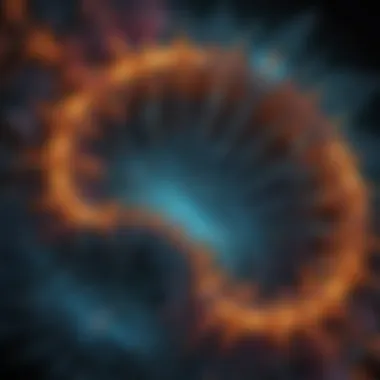
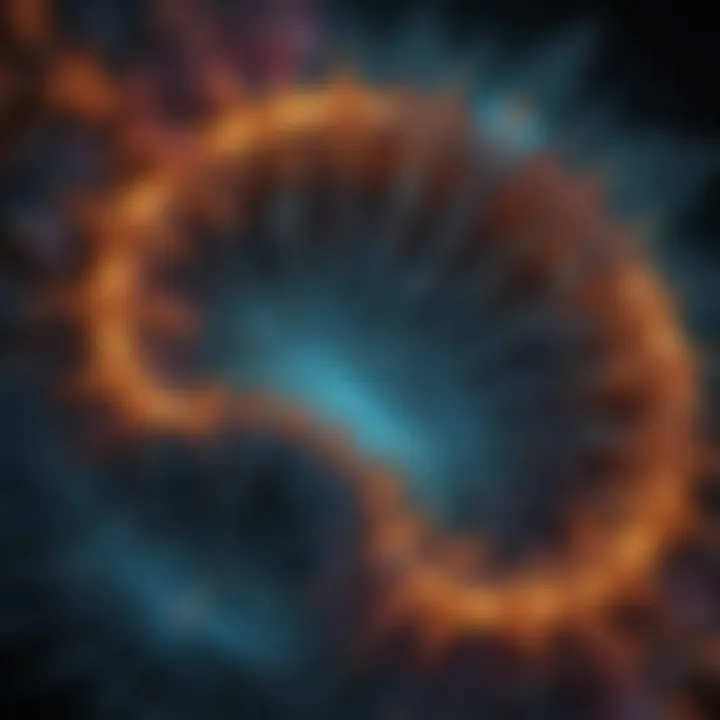
The selection of software is crucial for anyone interested in creating fractal art. Many programs specifically designed for fractal generation offer features that support both beginners and advanced users. Here are some popular software options:
- Apophysis: A free software mainly used for producing flame fractals. It allows users to create intricate designs and adjust various parameters.
- Mandelbulb 3D: This one focuses on 3D fractals. It offers excellent tools for visual exploration and rendering.
- Ultra Fractal: A robust program that provides various layering options. It suits both novice creators and seasoned professionals.
- Fractal Explorer: An intuitive tool to dive quickly into fractals with basic functionalities.
When selecting software, consider:
- User interface: Intuitive design helps simplify the learning curve.
- Features: Look for tools that allow for extensive customization.
- Community support: An active community can be invaluable for sharing knowledge and resources.
Hardware Considerations
While software plays a major role, hardware cannot be overlooked. The specifications of your computer will affect how smoothly you can create and render fractal art. Here are important elements to consider:
- Processor (CPU): A faster processor can handle complex calculations and rendering better. This is especially important when working on intricate designs.
- Graphics Card (GPU): A strong GPU can greatly enhance rendering speed, especially in 3D fractal art.
- RAM: More memory allows for faster processing and better multitasking while using different software.
- Disk Space: Ensure you have enough space for software installation and to save your fractal art.
Choosing the right equipment enhances your ability to work efficiently and creatively. As you dive into fractal art, being well-equipped aids in making your vision a reality.
"The right tools can transform your ideas into stunning visuals with ease and precision."
In summary, both software and hardware consideration are essential for anyone beginning the journey into fractal art creation. Understanding their importance will help in selecting the right tools for your artistic exploration.
Basic Techniques in Fractal Art Creation
Understanding the basic techniques in fractal art creation is foundational for anyone wishing to explore this intricate field. Mastering these techniques allows artists to unlock their creativity, as well as to appreciate the mathematical beauty behind fractals. These foundational skills often become the stepping stone toward more advanced practices. They not only make the process intuitive but also enhance the visual complexity within the fractal designs.
Generating Simple Fractals
Generating simple fractals serves as an entry point for those new to fractal art. To begin, one should familiarize oneself with specific fractal types like the Mandelbrot or Julia set. These fractals can be easily generated using most fractal software.
- Selecting Software: Start by choosing a user-friendly software tool that offers basic fractal generation capabilities. Programs like Apophysis or Fractal Explorer are great choices for beginners.
- Initial Setup: Open your fractal generation software and select a basic fractal type. For example, the Mandelbrot set is one of the most popular choices.
- Adjusting Levels: Set the zoom level to observe initial patterns and details. Simple adjustments in parameters can reveal the self-similarity inherent in fractals.
- Exporting Images: Once satisfied with the generated figure, export the image. This serves as a foundation for further enhancements while also providing a tangible result of your work.
Understanding how to generate simple fractals is critical. It builds both confidence and curiosity, encouraging artists to delve deeper into fractal creation.
Using Algorithms to Enhance Details
Algorithms play a crucial role in enhancing the details of fractal art. Leveraging specific algorithms can transform a simple fractal into a visually stunning masterpiece. Here’s what to consider:
- Understanding Key Algorithms: Familiarize yourself with key algorithms used in fractal generation. These may include escape-time algorithms or similarity transformations.
- Parameter Manipulation: Adjust various parameters. For instance, changing the color gradient or altering the depth of recursion can lead to vastly different outcomes. This exploratory process is vital for discovering new fractal patterns.
- Combining Techniques: Use algorithms in conjunction with basic techniques. This could involve layering multiple fractal types or blending them into a single image. Doing so enhances depth and complexity.
In summary, using algorithms effectively can elevate the quality of fractal art significantly. This not only demonstrates an understanding of mathematical principles but also allows for unique artistic expression.
"Fractal art is not merely about aesthetics; it encompasses a blend of mathematics, creativity, and technology that defines the art form."
By mastering these basic techniques, both novice and experienced artists can build a strong foundation in fractal art, facilitating growth and exploration in this fascinating domain.
Advanced Fractal Art Techniques
Understanding advanced fractal art techniques is crucial for anyone looking to elevate their creative expressions within this unique art form. Fractal art combines mathematical principles with artistic flair, allowing creators to generate images that embody complexity and elegance. By mastering advanced techniques, artists can create more personalized and intricate works. This section covers two key aspects: customizing parameters and employing color and texture effectively. Both elements play a vital role in enhancing the aesthetic appeal and depth of fractal artworks.
Customizing Parameters
Customizing parameters is one of the primary techniques for producing unique fractal pieces. Fractals are generated using mathematical models, and there are many variables involved. By adjusting these variables, artists can influence the appearance of their creations significantly.
For example, altering the equation parameters can change the shapes and patterns generated. Artists can tweak values like the zoom level, the angle, or the symmetry axis. Here are some parameters commonly modified:
- Zoom Level: The level of detail you see. Higher zoom can reveal intricate patterns.
- Iteration Depth: More iterations create more complex images but may require more computational power.
- Rotation Angles: Changing these can alter the orientation of the fractals.
By testing different combinations, artists can discover stunning visuals that are uniquely theirs. Furthermore, experimenting with parameters allows for a combination of mathematical precision and creative intuition.
Employing Color and Texture Effectively
While shapes create the structure of fractals, colors and textures provide the finishing touches that bring artworks to life. The choice of color can convey different emotions and themes, making it an essential consideration in the design process.
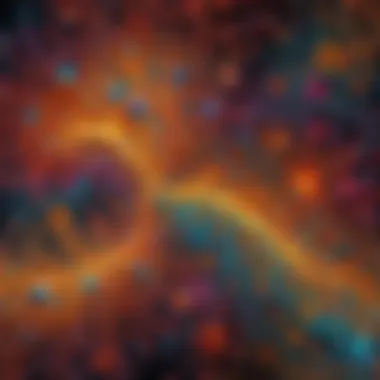
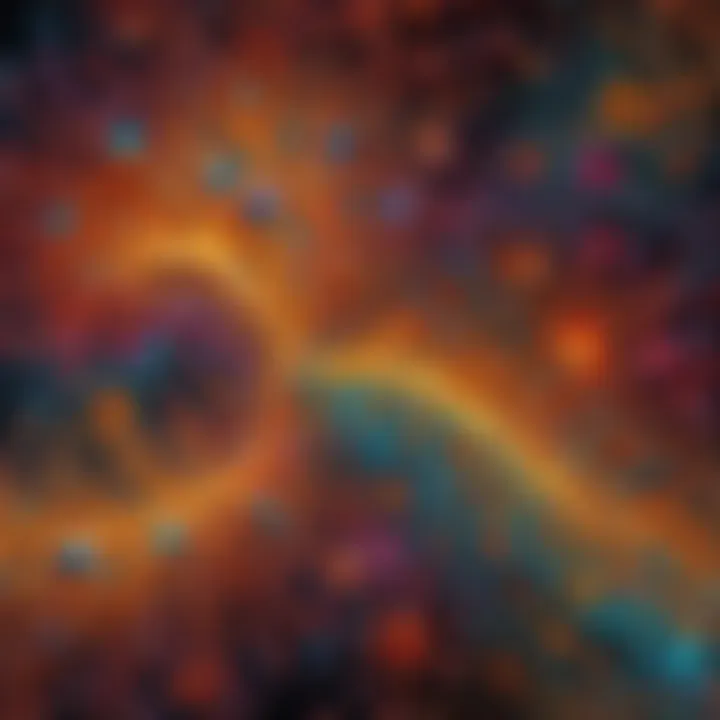
Here are some considerations for using color and texture in fractal art:
- Color Schemes: Selecting a balanced color palette can enhance the visual impact. Complementary colors can create contrast, while analogous colors promote harmony.
- Gradient Effects: Applying gradients can add depth and movement, making images more dynamic. Artists often use software tools to create smooth color transitions.
- Texture Overlays: Adding textures can provide a tactile quality to an image. This aspect can differentiate pieces within a digital canvas, creating a more realistic appearance.
Incorporating Mathematical Concepts
Mathematics forms the backbone of fractal art. Understanding key mathematical concepts can greatly enhance your ability to create intricate designs and appreciate the depth of fractals. By exploring the connection between mathematics and art, you can unlock new creative possibilities. This section discusses vital elements like iteration, recursion, and transformations, highlighting their benefits in crafting fractal visuals.
Understanding Iteration and Recursion
Iteration and recursion are essential principles in fractal creation. They allow artists to build complex structures from simple rules.
Iteration involves repeating a process multiple times. For instance, consider the Sierpiński triangle. You start with a triangle, then divide it into smaller ones, repeating the process at every new triangle. Each iteration produces more complexity, beautifully demonstrating how small changes can yield intricate results.
Recursion, on the other hand, is a function calling itself. In fractal art, this means using a set of rules that refer back to themselves to create depth and complexity. An example is the Mandelbrot set, where the output of mathematical functions leads back into the same function repeatedly, creating stunning visual intricacies.
By combining iteration and recursion, artists can create fractals that are not only visually appealing but also mathematically rich. They allow the creation of infinite detail within a finite space, which is one of the defining features of fractal art.
"Mathematics and art coexist beautifully in fractals. Through iteration and recursion, artists express complexity through simplicity."
Exploring Transformations in Fractals
Transformations play a crucial role in fractal art. In this context, transformations are operations applied to geometric shapes that change their positions, sizes, and orientations. Understanding how to manipulate shapes leads to innovative fractal designs.
Common transformations include:
- Translation: Moving a shape from one location to another without altering its size or orientation.
- Scaling: Adjusting the size of the shape. This can enhance details when creating fractals that exhibit different levels of zoom.
- Rotation: Changing the orientation of a shape around a particular point. This can lead to visually compelling patterns.
- Reflection: Flipping a shape over a line or plane to create symmetry, which is often a key aesthetic element in fractal art.
By applying these transformations, artists can take a basic shape and develop complex textures and patterns. The interplay between transformation and fractal structures leads to unique artworks that challenge traditional artistic norms. This practice demonstrates not only technical skill but also an appreciation for the mathematical underpinnings of art.
Understanding these mathematical concepts enriches one's approach to fractals, offering new creative paths and reinforcing the link between art and mathematics.
Practical Applications of Fractal Art
Fractal art is not only an intriguing exploration of mathematical beauty, but it also possesses various practical applications. This section aims to shed light on how fractals can be incorporated in different fields, enhancing both creativity and functionality in ways that are not immediately apparent. The importance of these applications lies in their ability to bridge the gap between art and science, prompting further interest in the subject among young enthusiasts. Through understanding these uses, one can appreciate how fractals play a significant role in various aspects of our lives.
Art Installation and écor
The connection between fractal art and interior design is profound. Artists utilize fractal patterns to create unique installations that captivate the viewer. From large canvases to 3D printed sculptures, the application of fractal designs can dramatically change the feel of a space. Intriguing fractal patterns have a way of drawing attention and inviting reflection. This gives decor a distinctive character beyond standard geometrical patterns.
Fractals can be powerful tools in architecture too. Buildings designed with fractal elements often blend harmoniously with nature, as they echo organic forms found in the environment. Such designs can evoke comfort and serenity, attributes highly valued in living space. Moreover, incorporating fractal art in public spaces can enhance community engagement and provoke thoughts about nature and its infinite complexity.
Potential benefits include:
- Aesthetic appeal: Fractal designs are striking and unique.
- Cognitive engagement: They stimulate curiosity and deeper observation.
- Environmental harmony: Fractal architecture tends to connect well with natural elements.
Educational Tools and Resources
Fractal art serves as an engaging medium for educational purposes. It can be instrumental in teaching concepts of geometry, calculus, and computer science. Using fractals in lessons provides a visual element that makes abstract ideas more tangible for learners. When students create their own fractal art, they engage with mathematical principles in a hands-on manner, promoting lasting understanding.
Educational resources include software tools that enable students to generate fractals with ease. Programs like Apophysis or Mandelbulb 3D allow for user-friendly interfaces to explore complex mathematical ideas through creativity.
Key points to consider:
- Visual Learning: Fractal art makes mathematics more approachable for students.
- Interactivity: Engaging with fractals fosters collaboration among peers.
- Rich content: Topics of iteration, recursion, and infinite detail become more vivid and understandable.
Fractal art not only illustrates mathematical concepts but also promotes critical thinking and creativity.
Engaging students through fractal art offers a fresh perspective on scientific principles. This duality of art and science encourages a holistic approach to education, making learning an enjoyable experience. While fractal art continues to evolve, its multifaceted applications will only grow, inspiring future generations to appreciate the beauty within mathematics.
Creating Fractal Art Step-by-Step
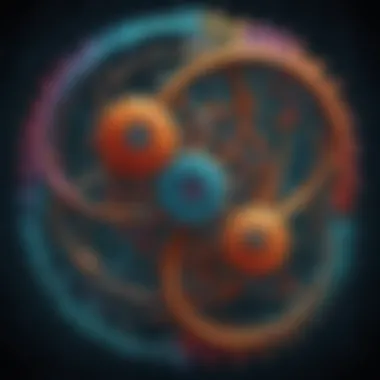
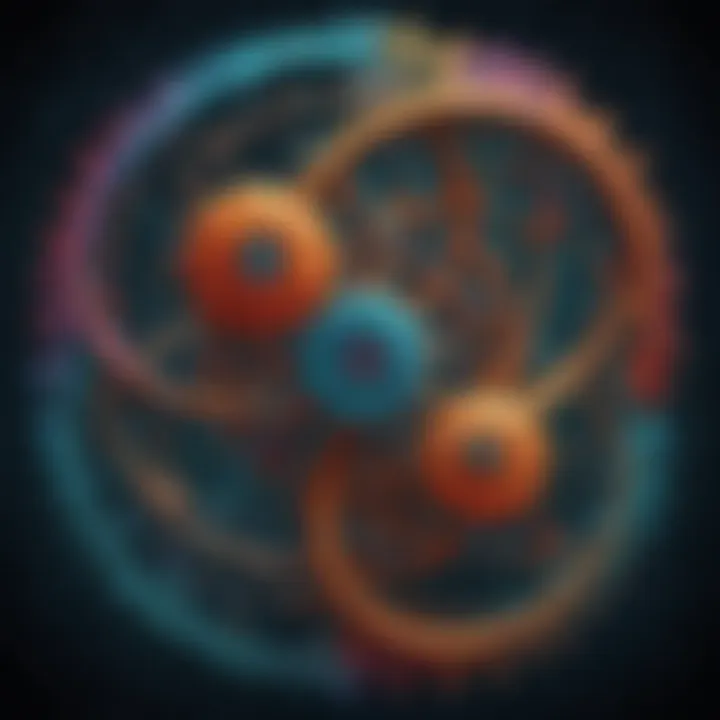
Creating fractal art is an exciting journey that combines both creativity and logical thinking. Understanding the process step by step helps in honing the skills needed to create intricate designs. By breaking it down, individuals can grasp complex concepts more easily, leading to successful artworks. This section will guide the reader through choosing the right tools and the generation process, ensuring a smooth experience in fractal art creation.
Choosing a Software Tool
Selecting the right software is crucial. There are many options available, each with unique features. Some popular tools include Apophysis, Mandelbulb 3D, and Ultra Fractal. Each of these applications caters to different user needs and artistic goals. Apophysis, for instance, is user-friendly and great for beginners. Mandelbulb 3D offers high-dimensional fractals and is well-suited for advanced users.
When deciding on a tool, consider the following:
- User interface: It should be straightforward and easy to navigate.
- Features: Check if it allows customization and manipulation of parameters.
- Community support: Software with active forums can provide assistance and ideas.
Step-by-Step Generation Process
Initial Setup
The initial setup is the first step towards creating fractals. It involves installing the software and configuring the basic settings. This phase is important because a good start sets the tone for the entire project. Proper configuration can make it easier to work later on.
One key characteristic of successful initial setup is accessibility. A beneficial choice involves software that provides tutorials or guides during installation. For example, Apophysis presents several walkthroughs, making it easier for new users. However, some setups can be cumbersome, which might discourage beginners.
Parameter Adjustment
Parameter adjustment brings the fractal to life. It involves tweaking various settings to influence the appearance of your fractal. Adjusting parameters, such as color, gradient, and shape, is essential to achieve the desired look. This phase is characterized by creative exploration as artists experiment with different values to see what works best.
A vital aspect of parameter adjustment is instant feedback. Many applications allow real-time rendering, meaning you can see changes immediately. This feature enhances creativity and keeps the user engaged. Although tweaking parameters can sometimes be overwhelming, it is a central part of the artistic process.
Final Touches
Final touches are critical for refining the artwork. This phase includes adding finishing elements such as shadows, highlights, and effects. These details can dramatically enhance the overall appearance. A key characteristic of final touches is enhancing depth, giving the image a more polished look and feel.
The importance of this step cannot be overstated. High-quality fractal art often lies in the details. Using tools like layers and filters makes this process easier. However, over-editing can lead to loss of original charm, so caution is necessary. Understanding how to balance these aspects is vital for creating stunning fractal art.
Further Exploration in Fractal Art
Further exploring fractal art is essential for both newcomers and seasoned artists. This section emphasizes the importance of engaging with broader communities and participating in competitions. By doing so, artists can enhance their skills, discover new techniques, and gain inspiration from others. The exploration process also aids in solidifying the knowledge gained throughout this article.
Fractal art requires encouragement and collaboration, making online communities a crucial element in a fractal artist's journey. When individuals come together to share their work, they create a more vibrant and supportive environment. This exchange can lead to new friendships, increasing motivation to continue creating.
Joining Online Communities
Being part of online communities allows artists to interact with like-minded individuals who share a passion for fractals. Websites such as reddit.com host groups where users share their works, seek advice, and learn about issues related to fractal expressions. Furthermore, platforms like Facebook provide spaces dedicated to fractal art where members can showcase their latest creations and receive feedback.
- Networking: Interacting with others can help establish connections. Artists can collaborate on projects or offer insights based on their experiences.
- Resource Sharing: Members often post tutorials, tools, and software recommendations. This can help beginners find their footing and assist experienced artists to refine their craft.
- Critique and Support: Feedback from other members can lead to improvement and innovation. Receiving constructive criticism fosters growth in one's art.
Joining a community is not only about sharing work but joining conversations. Engaging in discussions helps them stay updated on trends and methodologies that continually evolve in fractal art.
Participating in Competitions
Competitions offer a fantastic avenue for artists to test their skills and gain recognition. By entering contests, artists step outside their comfort zones, pushing the boundaries of their creativity. Many platforms, both online and in person, host these competitions, creating avenues for challenge and growth.
- Motivation: Competing can inspire artists to create pieces they may not attempt otherwise. The challenging nature of competition often brings out the best in artists.
- Visibility: Entering contests can lead to exposure. Winning or even just participating can provide a boost in visibility to an artist's portfolio.
- Feedback from Judges: Competitions usually have a panel of judges with expertise in fractal art. Their insights can be invaluable in refining one's style and technique.
"Art and community are intertwined; when artists connect, they inspire each other to reach new heights."
Engage and immerse in the world of fractal art to fully experience its possibilities.
Finale
The exploration of fractal art concludes with an understanding of its significance in merging creativity and mathematical concepts. This section emphasizes that fractal art is not merely a visual format but also an innovative way to appreciate complex mathematical relationships through aesthetic representation. As technology continues to evolve, so does the capability to create increasingly intricate fractals, thus inviting a wider array of artists and scientists to engage with this discipline.
The Future of Fractal Art
Looking ahead, the future of fractal art promises exciting advancements. Artists and mathematicians will likely develop new algorithms and software tools that simplify the fractal creation process. This could lead to an increased accessibility for young aspiring artists, allowing them to explore this intriguing field more easily.
Moreover, there is potential for integration with other artistic domains. For instance, virtual reality (VR) and augmented reality (AR) present opportunities to immerse audiences in fractal landscapes, breaking barriers between the viewer and the artwork.
Additionally, the intersection of fractal art with scientific research is noteworthy. Fields like medicine and climate science are beginning to use fractal analyses to understand complex systems. This creates a platform where artists can collaborate with scientists, contributing to education and awareness in innovative ways.
As we delve into the future, we should recognize the importance of community in this art form. Online platforms, such as Reddit and various artistic forums, allow artists of all ages to share their work and ideas. This fosters a culture of learning and collaboration.
In summary, the future of fractal art is bright and filled with possibilities. Its intersection with technology, science, and community will ensure that it remains relevant and dynamic, inspiring generations to come.







